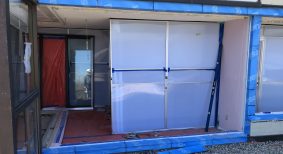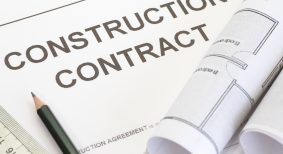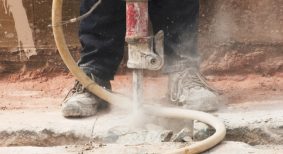Resilience and innovation have always been central to the building industry. However, due to the increased restrictions and challenges associated with COVID-19, the additional processes and measures required to address worksite safety have hurled the sector into unprecedented territory.
Jordan Swail, Project Engineer with RJC Engineers (RJC), has spent years dedicated to the restoration of existing buildings. His most recent projects include window, roof, and wall repair projects on large residential buildings. According to Swail, preventative measures required due to COVID-19 have become a significant issue, particularly for residential building projects, given the much higher occupancy levels, and challenges of physical distancing when residents are staying at home.
To help address these and other concerns about worksite safety amid COVID-19, Swail offers the following advice:
- Place barriers around work zones in occupied suites
 For properties undergoing intensive work, particularly at occupied suites, construction of temporary work enclosures can allow contractor staff to maintain physical distancing from residents. Modular hoarding products or sealed poly tarps can be installed quickly and provide safe and sealed airtight enclosures. Designated access paths to and from the worksite further reduce touch-points and keep interactions with occupants at a minimum.
For properties undergoing intensive work, particularly at occupied suites, construction of temporary work enclosures can allow contractor staff to maintain physical distancing from residents. Modular hoarding products or sealed poly tarps can be installed quickly and provide safe and sealed airtight enclosures. Designated access paths to and from the worksite further reduce touch-points and keep interactions with occupants at a minimum.
“A physical barrier can provide peace of mind to residents who are having their suite accessed by workers, and reduce the potential for conflicts with access requests,” he said.
- Separate workers from occupants in shared spaces

In larger multi-residential buildings, addressing the use and access of workers through shared spaces or common areas is an important part of reducing the risk of infection. By requesting workers to limit elevator use to specific blocks of time, placing them on service, and thoroughly cleaning after, the likelihood of residents and workers encountering one another is significantly reduced. Usage times should be scheduled in advance so residents can anticipate the inconvenience. Hand washing and hand sanitizing stations in common areas, as well as the requirement for personal protective equipment, will further reduce transmission.
“Elevators and lobbies are high risk areas where residents may not follow physical distancing guidelines,” warned Swail. “Separating time of use can reduce the risk of infection.”
- Update contracts to include COVID-19 requirements

Most pre-existing construction contracts don’t address the current COVID-19 crisis, which has resulted in contractors relying on Ministry of Labour guidance and government regulations. To protect building occupants, owners, and allow a higher standard of care, Swail advises that specific COVID-19 measures be worked into contracts for any upcoming work.
“With COVID-19 impacts anticipated well into 2021, we highly recommend adapting new contracts to address additional scheduling, access, and PPE requirements,” he said. “The ideal time to implement these changes is before the contract is signed.”
- Establish specific blocks of time for noisy work
 With a larger majority of people now working from home, noisy work has a higher potential for disruptions. Setting a proactive noisy work schedule – for example, two hours in the morning and two hours in the afternoon – and communicating that schedule to residents through the building management, will allow them to book their meetings accordingly, and ensure some degree of peace is maintained.
With a larger majority of people now working from home, noisy work has a higher potential for disruptions. Setting a proactive noisy work schedule – for example, two hours in the morning and two hours in the afternoon – and communicating that schedule to residents through the building management, will allow them to book their meetings accordingly, and ensure some degree of peace is maintained.
“Typical noisy hours of 8:00am to 5:00pm are no longer convenient with more residents likely working from home,” Swail said. “Limiting noisy work hours, or phasing it across different portions of the building, can go a long way to reduce complaints.”
To find out more about worksite safety measures during COVID-19, please reach out to Jordan Swail at jswail@rjc.ca or visit www.rjc.ca







